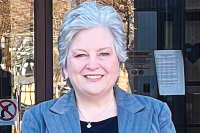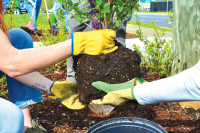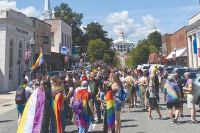The road to success: Blue Ridge Music Trails of Western North Carolina
 It was a decade in the making, but its origins are hundreds of years old.
It was a decade in the making, but its origins are hundreds of years old.
Partnering with the Blue Ridge National Heritage Area, the North Carolina Arts Council recently launched its latest initiative – the Blue Ridge Music Trails of North Carolina. Encompassing 29 counties in Western North Carolina, the trails were created to preserve, interpret and promote these rich pockets of music and dance that have had a profound impact on American culture and beyond.
“This region has an incredible wealth of history and heritage around our music,” said Angie Chandler, executive director of the BRNHA. “It has been part of these mountains for hundreds of years, and we want to share all of that.”
When Congress designated the BRNHA in 2003, five areas of focus were identified: agriculture, Cherokee history, craft, music and natural heritage. These areas have been explored during the course of the last decade, with each continuing to evolve and thrive. Though the first Blue Ridge Music Trails of North Carolina guidebook was published in 2003, it’s this updated, more comprehensive edition of the book (release date: April 22) that made 2013 the year for concentrating on music trails. To get the ball rolling, the book received funding from the North Carolina Department of Transportation.
“This is North Carolina’s definitive map to the traditions of old-time bluegrass music and dance,” said Dale Bartlett, BRMT coordinator for the BRNHA. “We’re developing this initiative to bring together these regions and make it marketable. As the heritage area has been able to spread its wings, finding opportunities and partnerships, it has been able to label these areas as assets that should get more attention.”
Related Items
Working with Appalachian folklorists Fred C. Fussell and Steve Kruger, the book identifies 60 locations within the 29 counties as major events, key historical sites and traditions that have been longstanding. The BRNHA itself has named and catalogued more than 160 sites, venues and events that occur in Western North Carolina.
“This book is for the consumer, the historian, the music buff and the curious traveler,” Bartlett said. “Now we’re taking it back to the people who have nurtured the asset throughout the years, helping them with promotion, cross-marketing and anything we can do to help build the network for the local resident and tourist.”
Right from the source
Though a lifelong musician, it wasn’t until banjoist/storyteller Laura Boosinger came to Western North Carolina as a teenager that she truly connected the beauty of sound and those who played and danced to it. Attending Warren Wilson College in the late 1970s, she found herself right at the source of real mountain culture and music. At that time, David Holt began to develop and direct the Appalachian Music Program at the college. The program was ahead of its time in terms of preserving the old-time music and also bringing forth legendary musicians from their front porches to the stage.
“I didn’t really know anything about mountain music. The music was incredible, but it was the people that fascinated me,” she said. “Why did these people do this? Why were these traditions in their families? I mean, I didn’t have any traditions that were generations old.”
An acoustic guitarist since she was 12, Boosinger fell in love with the banjo when banjoist Marc Pruett (of Balsam Range) gave her one to take home, look at and learn to play. It was at that moment when she began her journey down the rabbit hole of mountain music history and the faces behind the instruments.
“If you really think about it, how bluegrass grew out of old-time music and how it developed, it wouldn’t have existed without North Carolina,” she said. “People like Earl Scruggs and Doc Watson, what they brought to the music in terms of style and finger picking, were huge for how the sound evolved.”
Boosinger points to the current state of mountain music, where it continues to seep back into the mainstream consciousness after decades of depleting interest. With highly successful artists like Mumford and Sons, The Avett Brothers, The Band Perry and Yonder Mountain String Band selling out arenas worldwide, the sound appears to be in good hands, at least in music circles. But then when you add in enormous festivals like Merlefest, Bonnaroo and Wakarusa, where old-time and bluegrass music are one of key genres showcased, one begins to see the importance of preserving and promoting the original places and faces that make all of this possible.
“My hope is that this music will still remain a cultural treasure,” she said. “These families continue for generations, and this music needs to stay in people’s focus because it’s still evolving.”
The far west
Of the six regions featured in the guidebook, “Walking the King’s Highway” (Region 6) covers Haywood, Swain, Graham, Cherokee, Clay, Macon and Jackson counties. A popular square dance move, “Walking the King’s Highway” is a nod to the famous family heritage of Haywood clogger Sam Queen, grandfather of N.C. House Rep. Joe Sam Queen. A thoughtful and insightful essay on Appalachia heritage by Joe Sam Queen is featured in the guidebook. It speaks about the importance of embracing one’s own backyard and also makes note of the beloved Friday night traditional dances in Waynesville, which he is a caller for.
“My belief is that if we can keep our sense of self and place, we will thrive. Appalachia is a bastion of individualism and community,” he wrote. “There are not a lot of places left that have such a strong sense of place, but Appalachia’s one of them that does. It’s a wonderful place to visit, and to learn to feel that sense.”
Owner of Grandpa’s Music in Bryson City, Larry Barnett has been running the store for 12 years and is constantly asked where visitors can find the “real deal.”
“A very common question is where can they go hear music, not rock or blues, but traditional music,” he said.
Barnett said it’s important to preserve mountain music. For him, the sound stretches from the young children he currently gives lessons to all the way back to his grandfather, who played and ultimately influenced him.
“Kids are especially important because if they aren’t exposed to it, they won’t know it exists,” he said. “Luckily for us here, there are enough local people that play and the kids know what it is and how it should sound.”
Regardless of whether its performing on a large cosmopolitan arena or a tiny backwoods stage, what matters most is picking up the instrument and letting your fingers do the talking or grabbing the clogging shoes and dancing the night away.
“This music is unadulterated by any electronics,” Barnett said. “What I like is the fact you can walk out onto the porch and not have anything else than what’s in your hands.”
Where the heart is
With the initiative coming to fruition, the BRMT will begin conducting community input sessions in April for each region. Local leaders, residents, business owners and musicians are encouraged to participate and form a plan to strengthen partnerships. Besides the newly updated guidebook release, the BRMT website and map will be available in July, with the national marketing and public relations plan being launched in the fall.
“Hopefully, this will deepen education, resources and pride for this region as more people come and visit it,” Chandler said. “It’s amazing how few people really know the depth of history and heritage of this music. These people had an international impact coming right from these mountains.”
Chandler said the BRMT is looking for partners interested in supporting the initiative. There are also grants offered for music-related projects. An open call for the most recent cycle of proposals wrapped up in December, with the projects currently being reviewed. Chandler feels if attention can be called to the music, then it can be a catalyst for more public and private investment that is much needed in Western North Carolina.
“The key to our future is always staying tied to our history because our history is tied to the land and the natural importance of this land,” she said.
Want to help?
The Blue Ridge Music Trails is always looking for participation from local leaders, residents, business owners and musicians. If you have any ideas or information you think would help in making these trails thrive and evolve, contact Dale Bartlett, BRMT coordinator, at This email address is being protected from spambots. You need JavaScript enabled to view it. or 828.708.7907.
By the numbers
In preparation for the Blue Ridge Music Trails initiative, audiences at 26 traditional music venues in 18 counties where surveyed in 2011.
• These 26 venues equal $20.7 million in economic impact (which is less than 20 percent of the total venues identified in the guidebook/initiative).
• Attendees who travel specifically for an event spend 1.85 times more than visitors in the area for other reasons.
• Not holding these events would equal a loss of more than $13.5 million in spending in the region.
• 40 percent of attendees came specifically for an event.
• More than 160 music venues thrive in the region.
• 99 percent of attendees said they would return again.
• 116,000 attendees at the events studied.
• 2.9 - the average number of nights spent in the area by out-of-town audiences.
• 1.25 percent - the average percentage of annual household income spent on music.
• 10 states represented in audiences surveyed.
Region 6: Walking the King’s Highway
(Haywood, Swain, Graham, Cherokee, Clay, Macon, Jackson)
Major Events/Venues:
• Fading Voices Festival, Memorial Day Weekend, Little Snowbird Baptist Church, Robbinsville
• Smoky Mountain Folk Festival, Labor Day Weekend, Lake Junaluska
• Mountain Heritage Day, last Saturday in September, Western Carolina University, Cullowhee
• John C. Campbell Folk Festival, first full weekend in October, Brasstown
• Waynesville Street Dances, select Fridays on Main Street
• Music and dance at the Stompin’ Ground, Maggie Valley
• Maggie Valley Opry House, Maggie Valley
• Music in the Mountains at the Bryson City Railroad Depot
• Stecoah Valley Cultural Arts Center, Robbinsville
• Jimmy’s Pick N Grin, Andrews
• Clay’s Corner New Year’s Possum Drop and Weekly Jam Sessions, Brasstown
• Jam sessions at the T.M. Rickman Store, Cowee
• Thursday concert and jam session at Western Carolina Univeristy, Cullowhee









